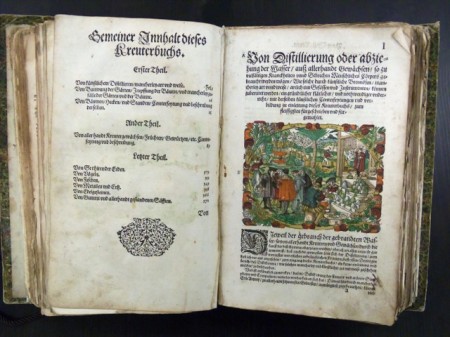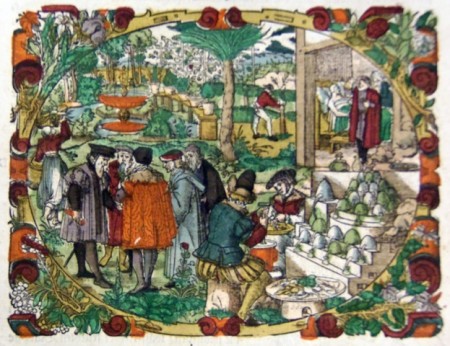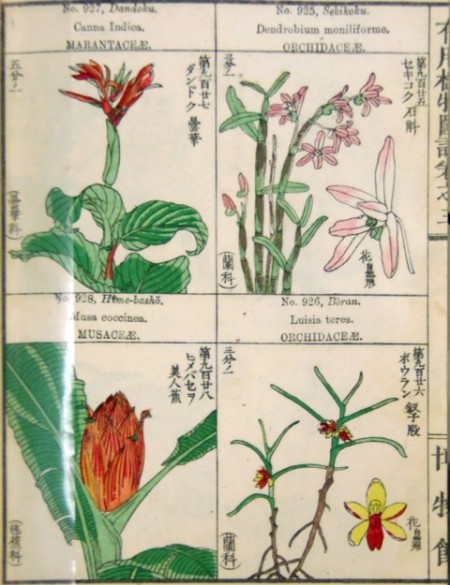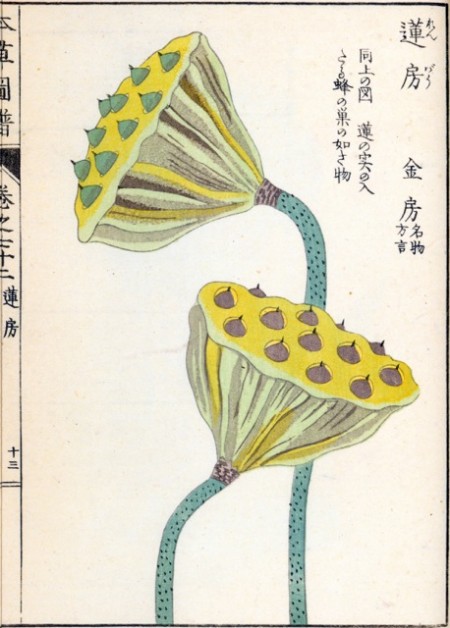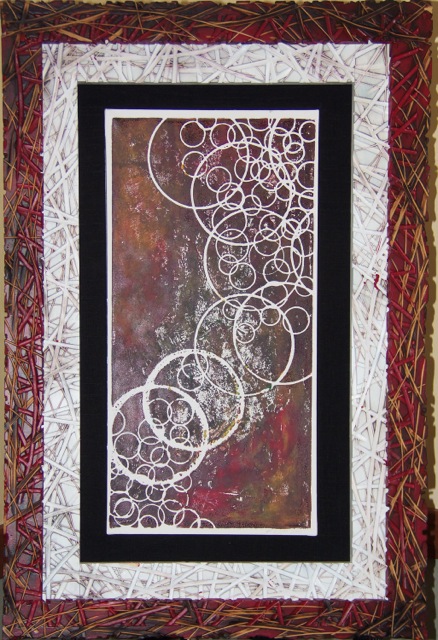The Lloyd Library is exhibiting a selection from their large collection of rare and modern works containing woodcuts in various applications. The majority of examples are from 16th -17th century European and Asian published volumes on zoological identification, herbal and medicinal information and processes and cultural research.
The first specimen is a volume on plants and distilling processes by Adam Lonicer, German physician and mathematician. This thickly-spined volume is opened to reveal its Fraktur texts inset with decorative black Fraktur versals. This book also features multicolor woodcut illustrations which, though severely limited in color palette, were more expensive and time consuming to produce. These woodcut illustrations by Lonicer are considered far more advanced than most produced during the same time.
There is a delightful display of Asian produced folded page volumes. These contain colorful illustrations of plant life as well as descriptions of medicinal applications and distillation processes. Notable from the Lloyd collection are the works by influential Chinese botanist, Hsen Hsu Hu, 1894-1968, who was the first Chinese PH.D to graduate from Harvard University. He is known as the founder of modern plant taxonomy in China. Japanese naturalist and pharmacognocist, Yoshio Tanaka, 1838-1915, used colorful woodcut illustrations to identify flora and fauna specimens in his native country and included woodcuts of painting technique and ikebana, the Japanese art of flower arranging.
This exhibit presents a glimpse of Nishiki-e, the Japanese term for the woodblock process through excellent prints, ink and carving tools and the baren, used to press the paper onto the inked block. In some cases, an actual carved, previously inked block is displayed with its pulled print product.
The Japanese term ukiyo-e is translated as “pictures of the floating world”. These multiple register woodcut prints by Japanese artists depict genre scenes from many aspects of Japanese cultural and urban life in Edo and other urban centers. First developed in the 1600’s, they became a significant artistic format, achieving great popularity through the 19th century internationally. The design quality as well as the thematic development of contemporary urban realism was an especially powerful influence on the European Impressionists. This exhibit displays a beautiful double page spread illustrating a flotilla of Japanese adults on individual rafts guided by strong men chest deep in ocean water as a distant mountain island presides on the horizon. A brilliant color palette and a diverse population portrayed with impeccable draughtsmanship are hallmarks of excellence here.
Also displayed are volumes that document the use of woodblock illustration to describe the cultural encounters of European explorers on other continents. Georg Schweinfurth, 1836-1925, was a German explorer and botanist who published “The Heart of Africa” in 1873. His book describes the geography, the people and their culture that he encountered in his travels in the African Congo. Schweinfurth made numerous drawings while on his adventures and translated over 100 sketches into monochromatic but finely detailed woodblock prints in his publication.
The oldest woodcuts in the Lloyd collection are published in a volume by Spaniard Ramon Llull, 13th century philosopher, writer and poet. Llull used math, symbolic notations and diagrams to relate philosophy, knowledge, theology and natural sciences to one another. His methods fostered a logical path toward the truths behind Christianity.
His book features a volvelle: a rotating wheel chart printed with woodcuts, which is an early example of a paper analog computer. The volvelle in the 13th century was used to calculate important data during the loss of the sun: time of night, the location of celestial bodies, or the proper timing of nocturnal administration of medicine.
Llull is reputed to have used the volvelle to explain purpose on earth thus pioneering computational theory.
Contemporary American, Ken Marshall, native Ohioan, displays his woodcut prints and art objects in an adjoining gallery. His work leans toward simple forms and movements orchestrated in a decorative singular composition in various versions as well as serial pieces displayed as stilled movements. Marshall’s prints are framed with a highly textural and bulky presentation that elaborately extend the print pattern. He states his goal as “to have the observer feel the texture through their vision, to have the observer WANT to touch the art…” The bulk of the exhibit are described as mixed media including construction wire and copper tubing displayed in a shadowbox format.
This exhibit impresses the viewer with the exquisite artistry of the wood block process in the hands of artists with a salute to continuing interest and contemporary expression.
On exhibit at Lloyd Library, Cincinnati: March 14th through June 3rd, 2016.
Marlene Steele teaches and paints in Cincinnati, Ohio and is a Founder of the Greater Cincinnati Calligraphers’ Guild.
